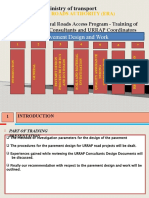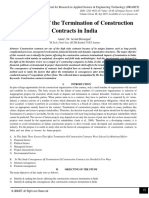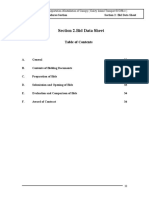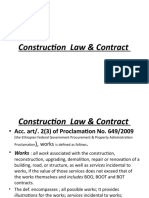Construction Economics (CENG-6108) : Assignment-1
Uploaded by
Zelalem TeshomeConstruction Economics (CENG-6108) : Assignment-1
Uploaded by
Zelalem TeshomeBHU- Construction Technology & Management Construction Economics
Construction Economics (CENG-6108)
Assignment- 1
1. A person deposited Birr.50,000 in a bank for one year and got Birr.75,000 at the end
of one year. Find out the total amount of interest and the rate of interest per year on
the deposited money.
2. If a person borrowed Rs.1,50,000 for one year and returned back Rs.1,75,000 at the
end of one year. Find out the total amount of interest and the rate of interest per
year on the borrowed money.
3. A person has taken a loan of amount of Birr.4,700,000 from a bank for a period of 5
years. Estimate the amount of money, the person will repay to the bank at the end
of 5 years for the following cases;
a) Considering simple interest rate of 9.5% per year
b) Considering compound interest rate of 12.5% per year.
4. What are the equivalent amounts of Birr.125000 (today) at an interest rate of 6.5%
per year for the following cases?
a) 1 year from now (future)
b) 1 year before.
c) 2.5 year from now (future)
d) 2 year before.
5. A construction engineer who is planning his retirement has decided that he will have
to withdraw Birr. 6,000 from his savings account at the end of each year. How much
money must the engineer have in the bank at the start of his retirement, if his
money earns 8.5% per year, compounded annually, and he is planning a 20-year
retirement?
6. Suppose an engineer deposits Birr. 340000 in a savings account that pays interest at
the rate of 7.5% per year, compounded annually. If all of the money is allowed to
accumulate, how much money will the engineer have after 10 years?
7. Engineer deposits Birr. 7850 in a savings account at the end of each year, starting
now, for the next 25 years. If the bank pays 8.5% per year, compounded annually,
how much money will accumulate by the end of the 25-year period?
8. A certain sum of money will be deposited in a savings account that pays interest at
the rate of 7.5% per year, compounded annually. If all of the money is allowed to
accumulate, how much must be deposited initially so that Birr. 50000 will have
accumulated after 15 years?
9. An engineer who is about to retire has accumulated $150,000 in a savings account
that pays 6.65% per year, compounded annually. Suppose that the engineer wishes
to withdraw a fixed sum of money at the end of each year for 10 years. What is the
maximum amount that can be withdrawn?
BHU- COTM DEPARTMENT 1
BHU- Construction Technology & Management Construction Economics
10. Suppose that a fixed sum of money, ‘A’, will be deposited in a savings account at the
end of each year for 15 years. If the bank pays 9% per year, compounded annually,
find ‘A’ such that a total of $550,000 will be accumulated at the end of the 15-year
period.
11. There are two alternatives for purchasing a concrete mixer. Both the alternatives
have same useful life. The cash flow details of alternatives are as follows;
Alternative-1: Initial purchase cost = birr.23,00,000, Annual operating and
maintenance cost = Birr.20,000, Expected salvage value = Birr.125,000, Useful
life = 5 years.
Alternative-2: Initial purchase cost = Birr.25,00,000, Annual operating and
maintenance cost = Birr.45,000, Expected salvage value = Birr.170,000, Useful
life = 5 years. Using present worth method, find out which alternative should
be selected, if the rate of interest is 7.5% per year.
The annual revenue to be generated from production of concrete (by concrete
mixer) from Alternative-1 and Alternative-2 are Rs.580000 and Rs..55000
respectively. Compute the equivalent present worth of the alternatives at the same
rate of interest i.e. 7.5% per year and find out the economical alternative.
12. There are two alternatives for purchasing an Aggregate Crusher Plant. Both the
alternatives have different useful life. The cash flow details of alternatives are as
follows;
Alternative-1: Initial purchase cost = birr.455,000, Annual operating and
maintenance cost = Birr.40,000, Expected salvage value = Birr.1,25,000,
Useful life = 5 years.
Alternative-2: Initial purchase cost = Birr.200,000, Annual operating and
maintenance cost = Birr.25,000, Expected salvage value = Birr.70,000, Useful
life = 10 years.
Using Future worth method, find out which alternative should be selected, if the
rate of interest is 10% per year.
13. There are two alternatives for purchasing a concrete mixer and following are the
cash flow details;
Alternative-1: Initial purchase cost = Birr.3500000, Annual operating and
maintenance cost = Rs.950000, Expected salvage value = Rs.225000, Useful life = 5
years.
Alternative-2: Initial purchase cost = Birr.2500000, Annual operating and
maintenance cost = Rs.85000, Expected salvage value = Rs.750000, Useful life = 10
years.
The annual revenue to be generated from production of Aggregate Crusher plant from
Alternative-1 and Alternative-2 are Rs.50000 and Rs.45000 respectively. Compute the
BHU- COTM DEPARTMENT 2
BHU- Construction Technology & Management Construction Economics
equivalent uniform annual worth of the alternatives at the interest rate of 8% per year and
find out the economical alternative.
14. A equipment supply contractor has two options (i.e. from two different
manufacturing companies, Company-1 and Company-2) to purchase a Laboratory
compressive strength equipment for bule hora university. The details of cash flow of
the two options are given below;
Company-1 Equipment: Initial purchase cost = Rs.7000000, Annual operating
cost including labor and maintenance = Rs.85000, Cost of new set of
materials to be replaced at the end of year ‘4’ and year ‘8’ = Rs.150000 each,
Expected salvage value = Rs.750000, Useful life = 10 years.
Company-2 Equipment: Initial purchase cost = Rs.5500000, Annual operating
cost including labor and maintenance = Rs.40000, Cost of new set of tires to
be replaced at the end of year ‘3’ and year,’6’= Rs.100000 each, Expected
salvage value = Rs.700000, Useful life = 10 years.
Determine which company equipment should be selected on the basis of equivalent
uniform annual worth at the interest rate of 10% per year.
BHU- COTM DEPARTMENT 3
You might also like
- Addis Proposed Arteficial Grass Socer Field Design With Boq75% (4)Addis Proposed Arteficial Grass Socer Field Design With Boq14 pages
- Causes of Variation Orders On Public Building Projects in Addis AbabaNo ratings yetCauses of Variation Orders On Public Building Projects in Addis Ababa9 pages
- Contract-Award-Information Nekempt - Bure - Lot I-III Works PDFNo ratings yetContract-Award-Information Nekempt - Bure - Lot I-III Works PDF9 pages
- Presentation On Pavement Design For URRAPNo ratings yetPresentation On Pavement Design For URRAP27 pages
- Causes of Delays and Their Impacts in Road Construction Proj-2No ratings yetCauses of Delays and Their Impacts in Road Construction Proj-296 pages
- Notice of Invitation For Bids Package VIIINo ratings yetNotice of Invitation For Bids Package VIII6 pages
- Jinka - Mendir Design Build Road Project Draft Concept Design Report, March 2017No ratings yetJinka - Mendir Design Build Road Project Draft Concept Design Report, March 201720 pages
- Unity University Adama Special Campus Department of Business Management Master of Business AdministrationNo ratings yetUnity University Adama Special Campus Department of Business Management Master of Business Administration10 pages
- Assessment of The Termination of Construction Contracts in India100% (1)Assessment of The Termination of Construction Contracts in India6 pages
- Construction Site Supervision COTM 3231No ratings yetConstruction Site Supervision COTM 323120 pages
- Specification and Bill of Quantities For The Construction of Meeting Hall Finishing Work at Hammer Worda, Dimeka Town100% (1)Specification and Bill of Quantities For The Construction of Meeting Hall Finishing Work at Hammer Worda, Dimeka Town19 pages
- Building Construction (CENG 3112) - Lecture Note - APRIL-2020No ratings yetBuilding Construction (CENG 3112) - Lecture Note - APRIL-2020269 pages
- Practice of Construction Planning in The Ethiopian Building Construction Industry: A Case Study On Selected Contractors in HAWASSA0% (1)Practice of Construction Planning in The Ethiopian Building Construction Industry: A Case Study On Selected Contractors in HAWASSA17 pages
- Addis Ababa University Walk Up Dormitory Building Project ConstructionNo ratings yetAddis Ababa University Walk Up Dormitory Building Project Construction21 pages
- Construction Performance and Resource Optimization Chapter One Overview of Construction Performance ManagementNo ratings yetConstruction Performance and Resource Optimization Chapter One Overview of Construction Performance Management62 pages
- Jinka Alternative 2 Engineer S Estimate RevNo ratings yetJinka Alternative 2 Engineer S Estimate Rev145 pages
- Basic Terms Floor Area Build Up Plinth EtcNo ratings yetBasic Terms Floor Area Build Up Plinth Etc5 pages
- Dire Dawa University Institute of Technology School of Civil Engineering AND Architechcher100% (1)Dire Dawa University Institute of Technology School of Civil Engineering AND Architechcher38 pages
- Chapetr Iv: Construction Project Scheduling TechniquesNo ratings yetChapetr Iv: Construction Project Scheduling Techniques98 pages
- Factors Affecting Construction Cost Estimation Addis Ababa Science and Technology University (Questionnaire)No ratings yetFactors Affecting Construction Cost Estimation Addis Ababa Science and Technology University (Questionnaire)6 pages
- Determine Whether Solutions Exist For Each of The Following Quadratic Equations. Where They Do Find The Solution(s)No ratings yetDetermine Whether Solutions Exist For Each of The Following Quadratic Equations. Where They Do Find The Solution(s)5 pages
- A. Sub Structure 1. Excavation & Earth Work: Take of Sheet 1100% (1)A. Sub Structure 1. Excavation & Earth Work: Take of Sheet 127 pages
- Contract and Business Law Assignment (Negele)100% (1)Contract and Business Law Assignment (Negele)2 pages
- U/Rate: Description Unit Qtty Amount A-Sub Structure 2. Concrete Work Item NoNo ratings yetU/Rate: Description Unit Qtty Amount A-Sub Structure 2. Concrete Work Item No9 pages
- Currency & Interest Rate Swaps: International Financial ManagementNo ratings yetCurrency & Interest Rate Swaps: International Financial Management34 pages
- Solved On May 1 201x George Company Received A 29 000 70 DayNo ratings yetSolved On May 1 201x George Company Received A 29 000 70 Day1 page
- TCF Personal Unsecured Secured Loan Application FormNo ratings yetTCF Personal Unsecured Secured Loan Application Form1 page
- Federal Bank - Savings Account Statement 01 Apr 2023 - 31 Mar 2024 - UnlockedNo ratings yetFederal Bank - Savings Account Statement 01 Apr 2023 - 31 Mar 2024 - Unlocked37 pages
- Submitted To: Rahul Agarwal Sir Submitted By: Varun Ahuja Jayesh SharmaNo ratings yetSubmitted To: Rahul Agarwal Sir Submitted By: Varun Ahuja Jayesh Sharma10 pages
- Lesson 1 Introduction To Coop Banking PDFNo ratings yetLesson 1 Introduction To Coop Banking PDF4 pages
- Sheet2: List of Financial Assistance For Anm/Gnm & Technical Course 2019-20No ratings yetSheet2: List of Financial Assistance For Anm/Gnm & Technical Course 2019-2029 pages


















































































































